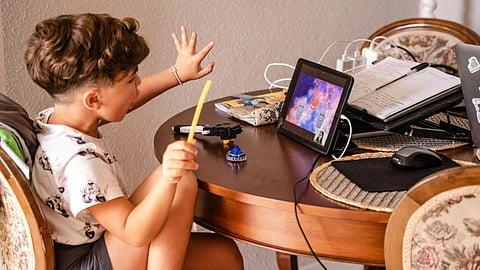

As mobile phones become more advanced, the number of users has also been increasing. In 2025 alone, there are about 7.3 billion active smartphone users globally, with 690 million of them from India.
A significant share of these users are from the younger generations, particularly Gen Z and Alpha. As a recent study from the All India Institute of Medical Sciences (AIIMS), Ranchi, revealed: children under the age of 5 now average more than 2 hours of screentime daily.
However, several paediatric experts also warn of dire consequences to allowing children to grow up surrounded by screens, including falling mental health, poor cognitive development, and an “addiction” to tech.
Inevitable or invasive?
While it could be argued that smartphones are now an inevitable part of childhood in the 21st century, experts caution against letting this notion guide parents.
“Yes, children are surrounded by screens everywhere. But in classrooms, it is only in the presence of a teacher,” says Dr Aaradhana Reddy, a counselling psychologist.
She added that children are quite capable of navigating the process of growing up without their eyes glued to screens, as was the norm before smartphones.
Once seen as a luxury product, smartphones are now considered a necessity. Many attribute this shift in attitude to the COVID-19 pandemic.
However, while children attended online classes on phones during lockdowns, psychologists argue that they should have been prevented from using them for hours at a stretch.
“During the pandemic, I made the children I work with learn multiplication tables and recite them on video calls. I even gave them prizes for getting them right,” says Dr Sripuja Siddamsetty, Consultant Clinical Psychologist.
According to her, this kept them studying all day instead of being on the phone.
This begs the question: If children can thrive without being hooked to screens, why do they end up with high screen times?
The answer? It’s because of the parents.
The “iPacifier”
For busy parents, handing a smartphone to their child is often a go-to strategy for keeping them engaged.
“In many households, both parents are employed and do not have the patience or time to deal with their children’s tantrums. They realised that children will stop crying if there’s a screen in front of them,” Dr Aaradhana explains.
Dr Shripuja further adds that children often gravitate towards phones in imitation of their parents. “They see their parents on the phone all the time, and want to do the same thing,” she states.
Thus, many children end up using phones as soon as they can hold them, leading to the very 21st-century phenomenon of the ‘iPad baby’.
“Smartphones were not a thing when I was growing up, and I turned out just fine. Children will be alright even without the use of phones.”
Dr Aaradhana Reddy, Counselling Psychologist
Children have been addicted to screens since the 1970s, when television became popular among households.
In an evocative poem, Roald Dahl captured this phenomenon:
“They sit and stare and stare and sit
Until they're hypnotised by it,
Until they're absolutely drunk
With all that shocking ghastly junk.
Oh yes, we know it keeps them still,
They don't climb out the window sill,
They never fight or kick or punch,
They leave you free to cook the lunch
And wash the dishes in the sink…”
Gen-Brainrot
Such early exposure to screens and electronic devices comes at a serious cost to the child: their cognitive and social development.
Dr Shripuja says, “Children are like sponges; they tend to take in everything they see, hear, touch, and perceive. However, there is only so much that they can get from a screen.”
Scientists agree that children with excessive screentime often show impaired socialisation skills, shorter attention spans, and poor emotional regulation — a collection of symptoms colloquially called “brainrot”.
The term gained popularity last year, with Oxford University Press naming it the “Word of the Year” in 2024. It is used to refer — albeit humorously — to a decline in mental abilities due to an excessive consumption of digital media.
“Children get so stimulated that they cannot process what they are witnessing, or know what they should pay attention to.”
Dr Shripuja Siddamsetty, Consultant Clinical Psychologist
Beyond the jokes, however, lie real concerns for children, caused by excessive screen time. Research by the American Academy of Paediatrics shows that just nine minutes of exposure to overstimulating content such as Cocomelon and Paw Patrol can reduce executive functioning among preschool-aged children.
“Children learn about the world by interacting with it, and through adequate sensory stimulation. Replacing that with a screen would take foundational experiences away from them,” notes Dr Shripuja.
Parental guidance paramount
By the time these children reach adolescence, they may become full-fledged screen addicts.
“Most of these children are already used to having extended hours of screentime, and their parents are usually too busy to keep them in check, resulting in unrestricted internet access,” points out Dr Aaradhana.
This means that children could be exposed to inappropriate content at a young age.
While digital platforms do have safety measures for children, these are not always airtight. In 2023, the Campaign for Accountability found that YouTube was recommending videos with gun violence to nine-year-old boys.
In addition, dangers like cyberbullying and sexual harassment have led 84 per cent of parents to worry about their children’s safety online, a Kaspersky study revealed.
More recently, young boys are falling prey to the ‘Manosphere’ — a loosely organised network of influencers espousing misogynistic rhetoric — leading them to adopt harmful views towards girls.
Even if children want to watch something, parents can turn it into a teaching moment, Dr Aaradhana says. “They can show informative movies and documentaries to their children,” she suggests.
“The phone can never replace the parent, and even if it does, it would be terrible at it,” she states.
